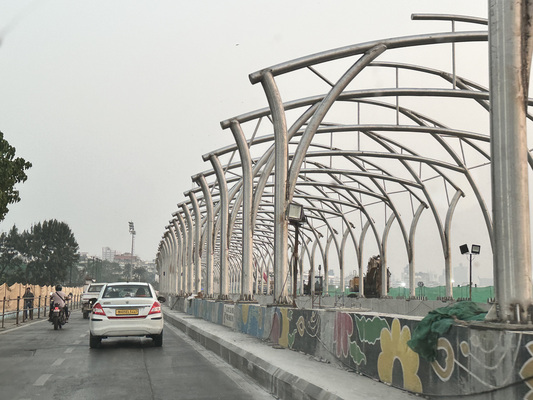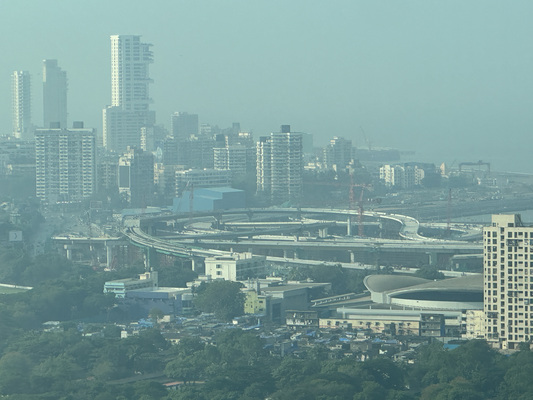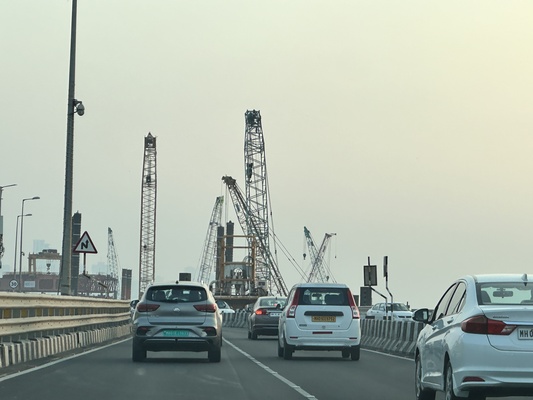- Large Infrastructure projects in India are being completed at a rapid pace, significantly quicker than historical projects.
- India is implementing sizeable infrastructure investments in an effort to propel the country to a $5 trillion gross domestic product (GDP).
An infrequent term for the iconic seafront strip of Mumbai’s Marine Drive is “the Queen’s Necklace.” It was named as such due to the appearance of the street lights as a sea of pearls floating in the massive blue grey sky of Mumbai. Marine Drive and Worli Sea Face are the two road borders between the Arabian Sea and South Mumbai, and they were hallmarks of my memories of the city.

As I returned home after a two-year hiatus, I expected to be welcomed as I always had by these massive roadways littered with vehicles surrounded by the waves of the sea. However, as my taxi crossed the Bandra-Worli Sea Link bridge to the Worli Sea Face, I was shocked to see that the construction of a sprawling eight lane highway system – the Mumbai Coastal Road Project – had consumed the majority of the view.
In a developing market that has historically struggled to complete infrastructure projects in budgeted time, the pace of this development was startling. During my earlier years in Mumbai, the Bandra-Worli Sea Link was the city’s largest ongoing project and had captivated the entire city. It was only 5.6 km with a total outlay of $300 million, but it took over 11 years to build.1 In comparison, the Mumbai Coastal Road – at 10.6 km, a daily capacity of 130,000 vehicles, and a total outlay of $1.8 billion – took only six years to complete.2
Across my trip, which spanned four major cities in India, I saw several similar infrastructure projects that were being completed at a rapid pace. The Delhi-Mumbai Expressway and the Mumbai Metro expansion in particular were memorable given their massive size and impact on logistics. The Delhi-Mumbai Expressway is 1,350 km with an outlay of $13.1 billion, and the Mumbai Metro expansion is budgeted at $13 billion. Both are expected to be completed before 2033.3
The swift pace at which these projects are being completed is a testament to the execution capabilities of the government, which has been led by the Bharatiya Janata Party (BJP) for the past 10 years and is focused on infrastructure as a core area of development. As of 2023, government officials estimated that infrastructure spending was on track to result in 38,650 km of highways, 400 semi-high speed trains, and 220 new airports by 2025.4
As a native of the country, I had become accustomed to partially completed roads, stalled bridges, and failed rail/metro installations. Witnessing this transformation was encouraging; I finally felt as though the country was starting to progress rapidly. As I traveled through Mumbai, Delhi, Chennai, and Baroda, I found similar sentiments in my interactions: people were filled with hope and positivity about the political system and the domestic economy.
With a stable political system the government should have a solid ability to bring its infrastructure plans to fruition. The outlook for the country’s $3.6 trillion GDP economy is promising, and the government’s stated goal of becoming a $5 trillion GDP economy seems attainable.5
Rohan DalalMumbai





- The views and information discussed in this commentary are as of the date of publication, are subject to change, and may not reflect Seafarer’s current views. The views expressed represent an assessment of market conditions at a specific point in time, are opinions only and should not be relied upon as investment advice regarding a particular investment or markets in general. Such information does not constitute a recommendation to buy or sell specific securities or investment vehicles. It should not be assumed that any investment will be profitable or will equal the performance of the portfolios or any securities or any sectors mentioned herein. The subject matter contained herein has been derived from several sources believed to be reliable and accurate at the time of compilation. Seafarer does not accept any liability for losses either direct or consequential caused by the use of this information.
- “Bandra Worli Sea Link: Hi-tech incompetence?.” The Economic Times, July 1, 2009.
- “L&T’s Mumbai Coastal Road Project: A Sustainable Urban Transformation.” L&T Construction; Acharya, Pratip and Sweety Adimulam. “High-speed coastal road corridor: A sea-change in the way Mumbai drives.” The Indian Express, June 19, 2023; “Elevating Connectivity: A Closer Look at the Upcoming Mumbai Coastal Road Project.” Lodha, December 7, 2023; “Mumbai Coastal Road: Second underground tunnel breakthrough takes place, check salient features.” Mid-Day, May 30, 2023.
- “From Delhi to Mumbai in 12 hours flat? Expressway to be ready in 3 years.” Business Standard, April 17, 2018; “Mumbai’s First Underground Transit System.” Construction World, January 3, 2022; Ganapathy, Nirmala. “Building Boom in India.” The Straits Times, August 12, 2023.
- Ganapathy, Nirmala. “Building Boom in India.” The Straits Times, August 12, 2023.
- Keshri, Gyanendra. “India to be $5 trillion economy by 2027-28: Finance Minister.” Deccan Herald, January 11, 2024.
![[Chrome]](/_layout/images/ua/chrome.png)
![[Firefox]](/_layout/images/ua/firefox.png)
![[Opera]](/_layout/images/ua/opera.png)
![[Microsoft Edge]](/_layout/images/ua/edge.png)